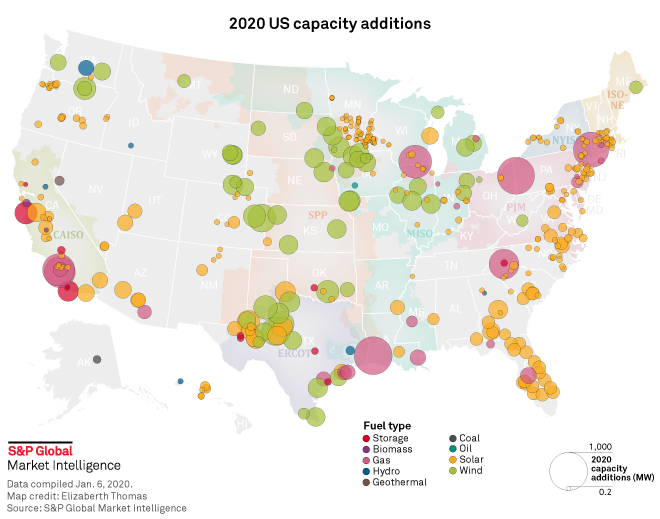S&P Global Offerings
Featured Topics
Featured Products
Events
S&P Global Offerings
Featured Topics
Featured Products
Events
S&P Global Offerings
Featured Topics
Featured Products
Events
Banking & Capital Markets
Economy & Finance
Energy Transition & Sustainability
Technology & Innovation
Podcasts & Newsletters
Banking & Capital Markets
Economy & Finance
Energy Transition & Sustainability
Technology & Innovation
Podcasts & Newsletters
S&P Global Offerings
Featured Topics
Featured Products
Events
25 Jan, 2021
By Krizka Danielle Del Rosario
The U.S. saw a total of 24,870 MW of new generating capacity enter the grid in 2020, 35.2% higher than the 18,400 MW that came online in the previous year.
Meanwhile, 12,946 MW were permanently removed from service in 2020, creating a net addition of 11,924 MW to the U.S. grid.
Wind accounted for two-fifths of 2020's total additions, amounting to 10,790 MW, followed by solar with a 27.6% share. Gas-fired capacity, which supplied nearly half of 2019's capacity additions, only accounted for about a quarter in 2020.

Among organized power market regions, the Midcontinent ISO had the largest amount of 2020 capacity additions, with 5,119 MW, equivalent to 20.6% of the nation's total. Wind accounted for 53.1%, followed by gas with a 37.5% share. Among the facilities that came online in the region was Entergy Corp.'s 1,000-MW Lake Charles Power Station. The gas-fired facility, located in Calcasieu County, La., was the largest single U.S. plant addition during the year.
The Electric Reliability Council of Texas Inc. region was just behind MISO, with 5,004 MW added in 2020. Of that total, solar and wind accounted for 93.1%, with gas and storage capacity making up the remainder. Three of the larger projects installed in the region were the 525-MW Aviator Wind Project (Grape Creek) in Coke County, which changed hands over the summer and is now owned by CMS Energy Corp. and The Kansai Electric Power Co. Inc.; Clearway Energy Inc.'s 419-MW Mesquite Star Wind Project (Whitehorse Wind) in Nolan County; and Ørsted A/S' 338-MW Sage Draw Wind Project in Lynn County. At least a portion of each plant's output is secured under a long-term contract with a corporate buyer.
More than 7,100 MW of capacity was installed outside of power market regions, in the Southeast and western U.S., the bulk of which are solar, wind and gas. Some notable additions include Duke Energy Corp.'s Asheville CC plant in Buncombe County, N.C., with 587 MW of gas-fired capacity and which in part replaced the output of a coal-fired plant that was retired, and Xcel Energy Inc.'s 500-MW Cheyenne Ridge Wind farm in Cheyenne County, Colo., which also included a related transmission line.
The year 2020 also saw a huge growth in battery storage, with 640 MW of capacity from stand-alone battery stations coming online, compared to 124 MW in 2019. About 89% of the capacity is located in the California ISO region. In the last quarter of 2020, the first phase of Vistra Corp.'s Moss Landing Energy Storage Facility came online with 300 MW. The facility, located in Monterey County, Calif., is considered one of the world's largest storage projects to date. Phase two of Moss Landing is expected to add another 100 MW once it reaches completion in the third quarter of 2021.

